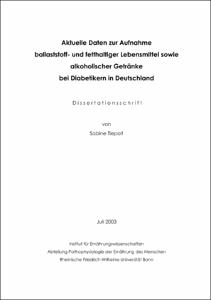Aktuelle Daten zur Aufnahme ballaststoff- und fetthaltiger Lebensmittel sowie alkoholischer Getränke bei Diabetikern in Deutschland

Aktuelle Daten zur Aufnahme ballaststoff- und fetthaltiger Lebensmittel sowie alkoholischer Getränke bei Diabetikern in Deutschland

| dc.contributor.advisor | Pietrzik, Klaus | |
| dc.contributor.author | Tiepolt, Sabine | |
| dc.date.accessioned | 2020-04-06T08:12:16Z | |
| dc.date.available | 2020-04-06T08:12:16Z | |
| dc.date.issued | 2004 | |
| dc.identifier.uri | https://hdl.handle.net/20.500.11811/1874 | |
| dc.description.abstract | Ziele: Ziel der Erhebung war es, die Häufigkeiten des Verzehrs kohlenhydrat- und ballaststoffhaltiger sowie typischer fetthaltiger Lebensmittel und den Konsum alkoholischer Getränke bei einer großen Anzahl von Diabetikern in Deutschland zu untersuchen. Zudem sollte bewertet werden, inwieweit die aktuellen Ernährungsempfehlungen für Diabetiker von den Patienten in die Praxis umgesetzt werden und ob sich Unterschiede in der Nahrungsaufnahme für verschiedene Risikogruppen ergeben. Methodik: Die 1988 untersuchten Diabetiker (930 Männer, 1058 Frauen, mittleres Alter: 57 (18-93) Jahre, mittlere Diabetesdauer 9 (0,1-56) Jahre, 17% derzeitige Raucher, 33% mit regelmäßiger sportlicher Aktivität, mittlerer Body Mass Index 29±6kg/m², 57% mit Hyperlipidämie, 62% mit Hypertonie, 13% nach Herzinfarkt, 7% nach Schlaganfall) wurden konsekutiv in 18 Einrichtungen in Deutschland rekrutiert. Angaben zur Person, zur Therapie und zu den Risikofaktoren wurden in einem standardisierten Fragebogen, die Verzehrshäufigkeiten mit einem validierten Food Frequency Questionnaire (FFQ) erfasst. Ergebnisse: Das untersuchte Diabetikerkollektiv entsprach in seiner Altersverteilung der Diabetikersubgruppe des populationsbezogenen Bundes-Gesundheitssurveys aus dem Jahr 1998. Häufiger als 1-mal pro Tag Obst und häufiger als 1-mal pro Tag Gemüse verzehrten 15,1% bzw. 3,7% der Diabetiker. 49% der Untersuchten aßen 1-2-mal pro Woche Fisch und 29% verwendeten täglich Öl. Die Gesamtalkoholaufnahme bei Frauen betrug 2,8g pro Tag und bei Männern 7,7g pro Tag. Die obere Empfehlungsgrenze für einen akzeptablen täglichen Alkoholkonsum überschritten 4,8% der Diabetikerinnen und 2,3% der Diabetiker. Diabetiker die regelmäßig Alkohol konsumierten, aßen signifikant seltener ballaststoffhaltige und häufiger fetthaltige Lebensmittel. Raucher ohne sportliche Aktivität verzehrten signifikant häufiger täglich Fleisch und Wurst, aber seltener Öl und seltener 1-2-mal pro Woche Fisch als sportlich aktive Nichtraucher. Diabetiker bei denen ein Metabolisches Syndrom diagnostiziert worden war, aßen signifikant häufiger fettreduzierte Produkte und seltener fetthaltige Lebensmittel [Summenscore: 54 (37-66) vs. 52 (33-65), p< 0,0001]. Schlussfolgerung: Gemessen an den aktuellen Ernährungsempfehlungen verzehren Diabetiker derzeit noch unzureichend häufig Obst, Gemüse und Fisch. Bezüglich der Empfehlungen zur Auswahl und Verzehrshäufigkeit fetthaltiger Lebensmittel zeigen Diabetiker mit der Diagnose Metabolisches Syndrom günstige Verhaltensmodifikationen wohingegen Raucher ohne sportliche Aktivität und Diabetiker mit regelmäßigem Alkoholkonsum ein ungünstiges Verzehrsmuster aufweisen und von daher der besonderen Ernährungsberatung bedürfen. | en |
| dc.description.abstract | Current intake data of fibre and fat containing foods and alcoholic drinks in a diabetic cohort from Germany Aims: This study aimed to assess the frequency of intakes of carbohydrate-, fibre- and fat-containing foods as well as of alcoholic drinks in a diabetic cohort from Germany. Furthermore it analysed in how far the current nutritional recommendations for individuals with diabetes are implemented, and whether differences can be found between the food intake patterns of certain high risk groups. Methods: In total 1988 diabetic patients (930 men, 1058 women, mean age: 57 (18-93) years, mean diabetes duration: 9 (0.1-56) years, 17% current smokers, 33% with regular physical activity, mean body mass index: 29±6kg/m²) were consecutively recruited in 18 centres throughout Germany. Demographic data and information on therapy and risk factors were documented in a standardized questionnaire, the food intake was assessed by using a validated food frequency questionnaire (FFQ). Results: In the cohort an age distribution was achieved comparable to the diabetic subgroup of the population-based German National Health Survey conducted in 1998. Of the persons with diabetes 15.1% or 3.7%, respectively, consumed fresh fruits or vegetables more frequently than once a day. Overall 49% of the patients consumed fish 1-2 times per week and 29% took vegetable oils on a daily basis. The total alcohol intake per day was 2.8g for women and 7.7g for men. The upper level of acceptable daily alcohol intake was exceeded by 4.8% of the female and 2.3% of the male persons with diabetes. Individuals with diabetes who used to drink alcohol on a regular basis consumed significantly less frequently fibre and more often fat-containing foods (p<0.05) . Compared to non-smokers with regular physical activity smokers without physical activity consumed more often meat and sausages, but less frequently vegetable oils. Patients in whom the metabolic syndrome was diagnosed took more frequently fat-reduced products and less frequently high fat foods [Sumscore: 54 (37-66) vs. 52 (33-65), p<0.0001]. Conclusions: Taking the current nutritional recommendations as the reference the consumption of fresh fruits, vegetables and fish is still inadequate in persons with diabetes. Patients with the metabolic syndrome show favourable dietary modifications with regard to the choice and intake frequency of fat-containing foods, whereas smokers without regular physical activity and regular alcohol drinkers present with an unfavourable nutrition intake pattern. Therefore these groups need special advice concerning their nutritional intake. | en |
| dc.language.iso | deu | |
| dc.rights | In Copyright | |
| dc.rights.uri | http://rightsstatements.org/vocab/InC/1.0/ | |
| dc.subject.ddc | 610 Medizin, Gesundheit | |
| dc.subject.ddc | 640 Hauswirtschaft und Familienleben | |
| dc.title | Aktuelle Daten zur Aufnahme ballaststoff- und fetthaltiger Lebensmittel sowie alkoholischer Getränke bei Diabetikern in Deutschland | |
| dc.type | Dissertation oder Habilitation | |
| dc.publisher.name | Universitäts- und Landesbibliothek Bonn | |
| dc.publisher.location | Bonn | |
| dc.rights.accessRights | openAccess | |
| dc.identifier.urn | https://nbn-resolving.org/urn:nbn:de:hbz:5n-03223 | |
| ulbbn.pubtype | Erstveröffentlichung | |
| ulbbnediss.affiliation.name | Rheinische Friedrich-Wilhelms-Universität Bonn | |
| ulbbnediss.affiliation.location | Bonn | |
| ulbbnediss.thesis.level | Dissertation | |
| ulbbnediss.dissID | 322 | |
| ulbbnediss.date.accepted | 20.11.2003 | |
| ulbbnediss.institute | Landwirtschaftliche Fakultät : Institut für Ernährungswissenschaften | |
| ulbbnediss.fakultaet | Landwirtschaftliche Fakultät | |
| dc.contributor.coReferee | Remer, Thomas |
Dateien zu dieser Ressource
Das Dokument erscheint in:
-
E-Dissertationen (1096)




